Coade Stone Urns and Pedestals
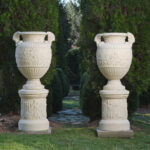
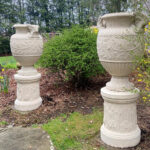
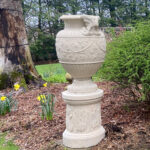
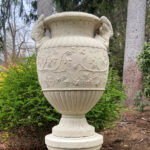

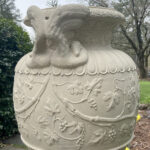
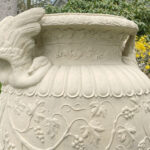
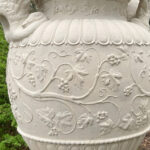
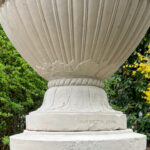
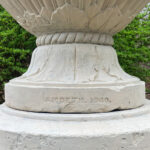
Coade Stone Urns and Pedestals
Item #06600
An exceptional pair of stoneware urns by the Coade manufactory of Lambeth (London), the body of each semi-lobed, amphora-shaped vessel ornamented with grape vines, the foot of each with acanthus leaves, the rims ornamented with egg and dart motif, and the handles of each comprised of swans with outstretched wings, on columnar stoneware pedestals with a frieze of cattails and other water plants, marked “LAMBETH 1840”, English, 1840.
65 ins. high overall x 28 ins. wide x 20 ins.deep. pedestals 28 inches high
George Coade, his wife Eleanor, and their daughter Eleanor founded Coade’s Artificial Stone Manufactory in 1769. Assisted by renowned sculptor John Bacon (1740-1799), the younger Eleanor (1733-1821) became the driving force behind the company, making the first weather-hardy artificial stone that was more durable, less expensive and more efficient to produce than carved stone. Their proprietary product, Coade stone, a type of stoneware, was kiln-fired twice for extreme durability. The Coade Manufactory produced classically inspired architectural features for more than 150 British architects, among them Robert Adam (1728-1792) and Sir John Soane (1753-1837). Examples of Coade’s work are on the finest structures and in the most superior gardens in England, many of them royal commissions, including The Royal Pavilion in Brighton, St. George’s Chapel at Windsor, and Buckingham Palace in London. When, in 1799, John Bacon died, Eleanor (the younger) made her cousin, John Sealy, a partner, thereby establishing “Coade & Sealy”. Later, upon Mr. Sealy’s death in 1813, Eleanor hired a distant relation, William Croggon, to manage the day-to-day operations at the manufactory. Eleanor Coade died in 1821, but Croggon maintained a robust business until he suddenly went bankrupt in 1833 for reasons that are not entirely understood. Nevertheless, the Coade name was carried on by the two lessees of the property, John Danforth Greenwood and Thomas Routledge. This rare pair of urns would have been produced under their tenure, in 1840, at the tail end of Coade’s long and fruitful period of production. Three years later, Mark Blanchard would purchase the bulk of Coade’s molds and patterns, carrying on under his own name the impeccable quality and durability of Coade’s artificial stone.